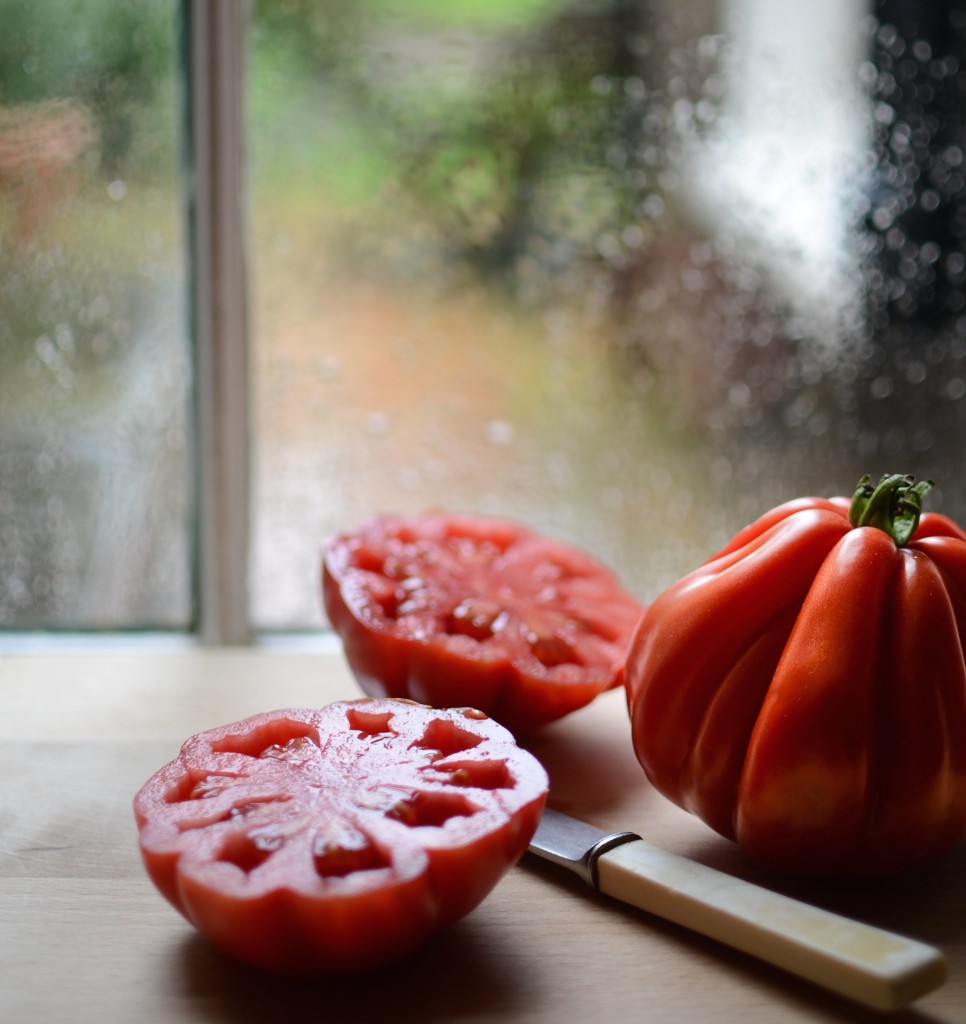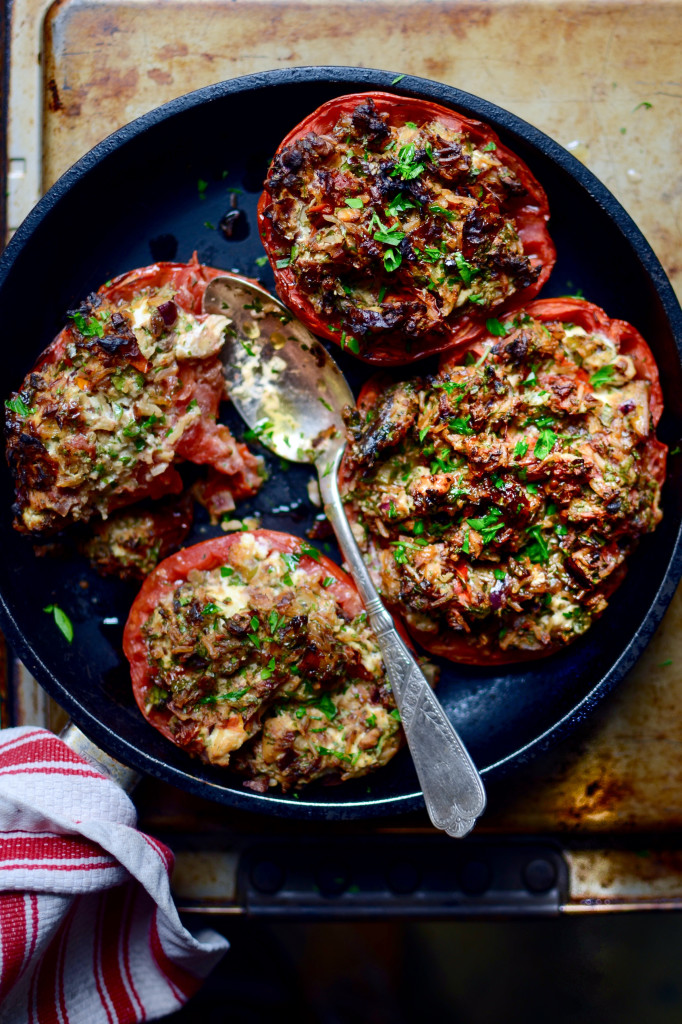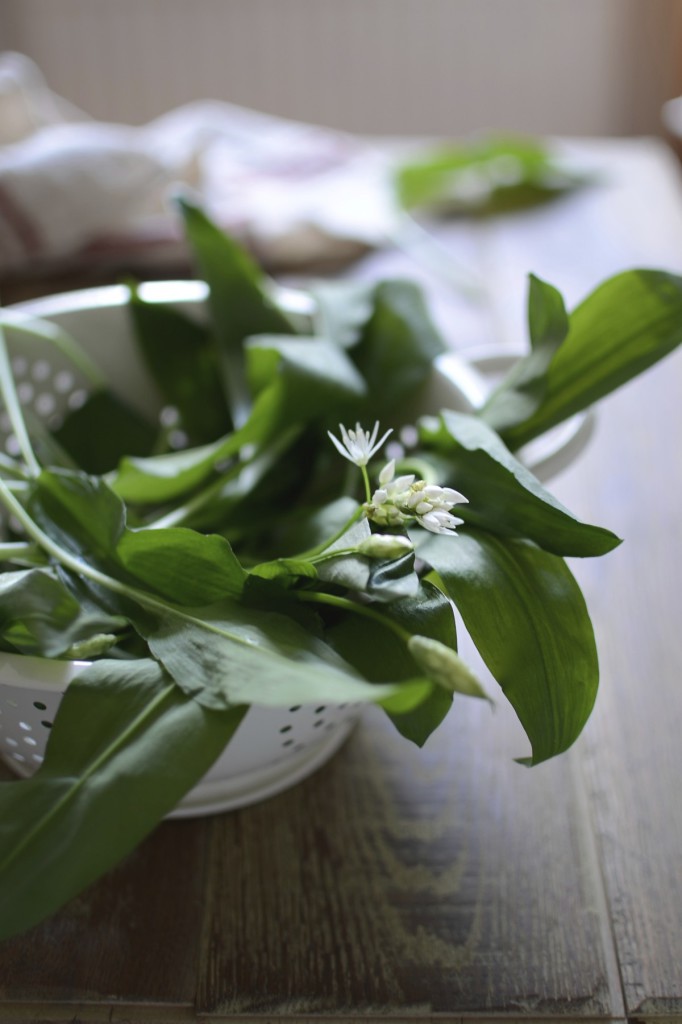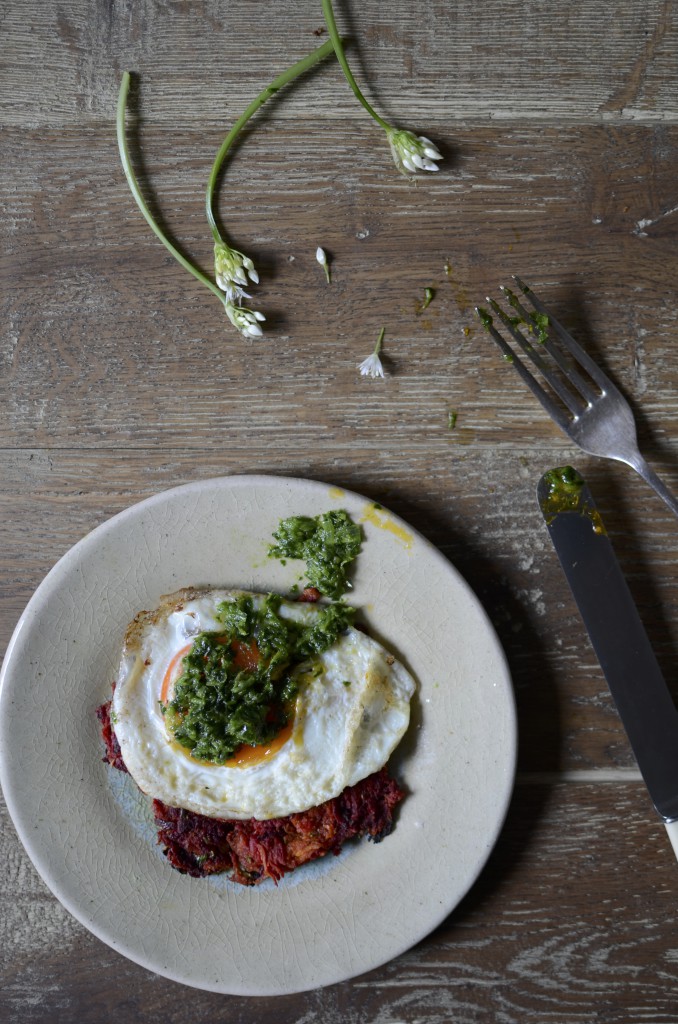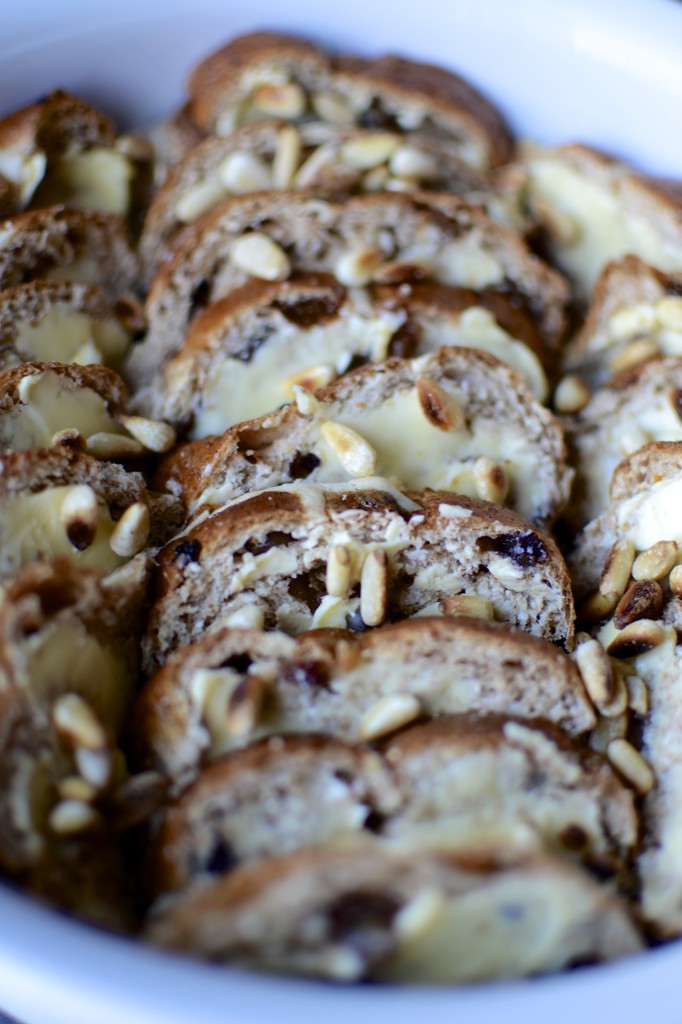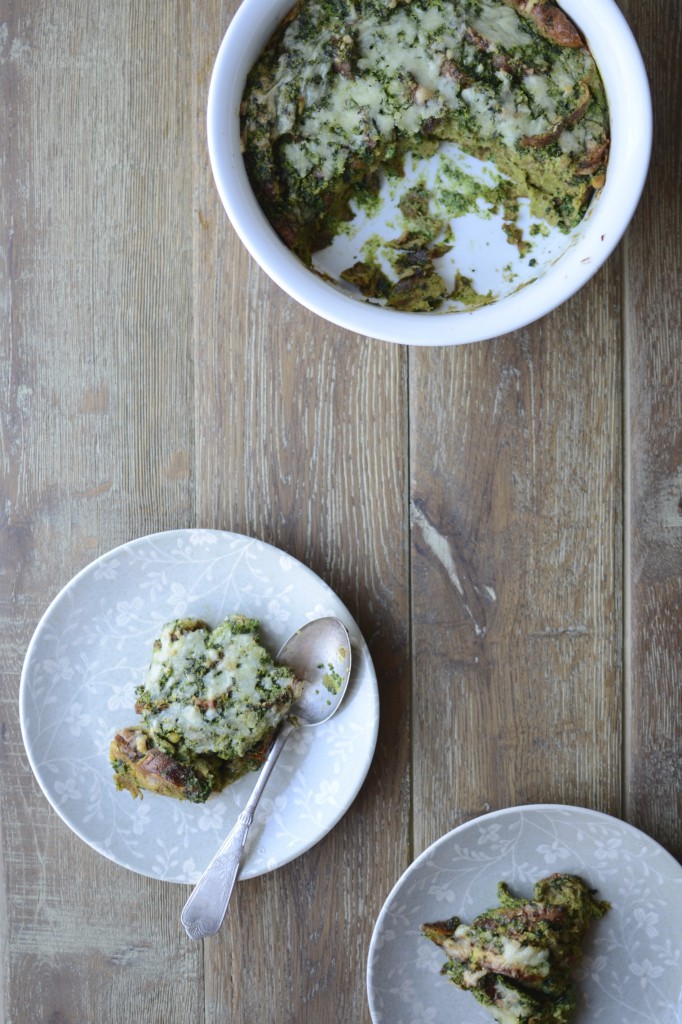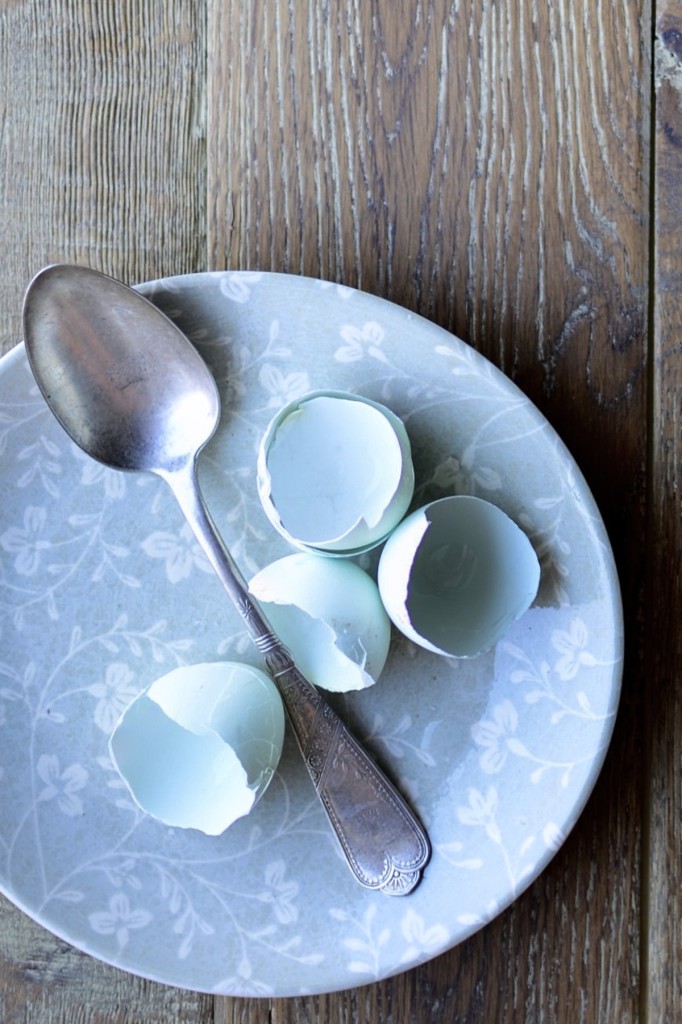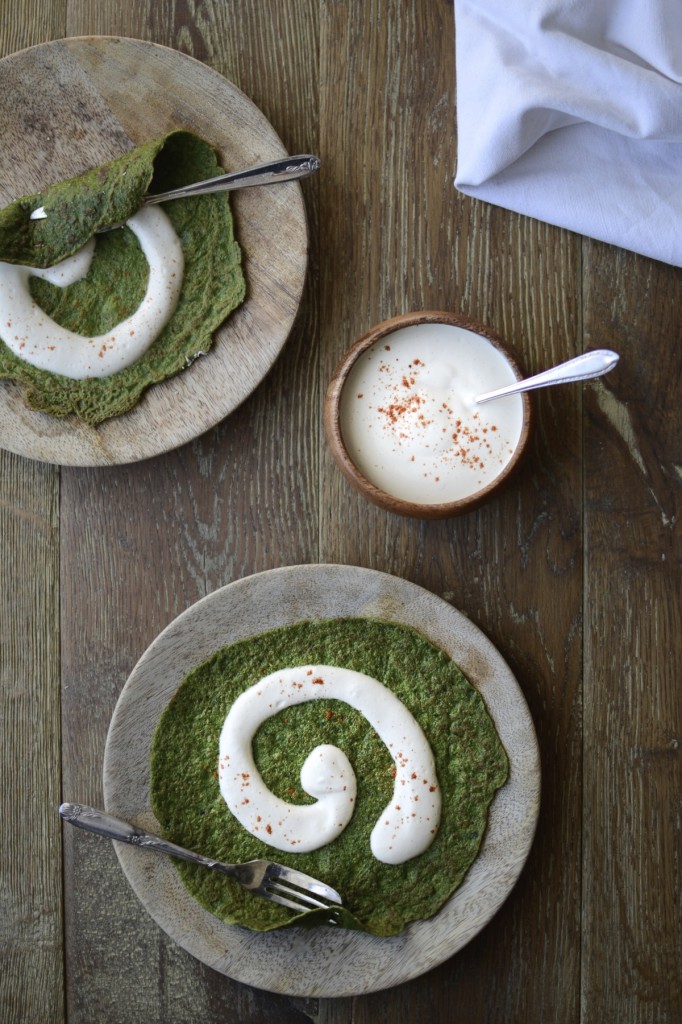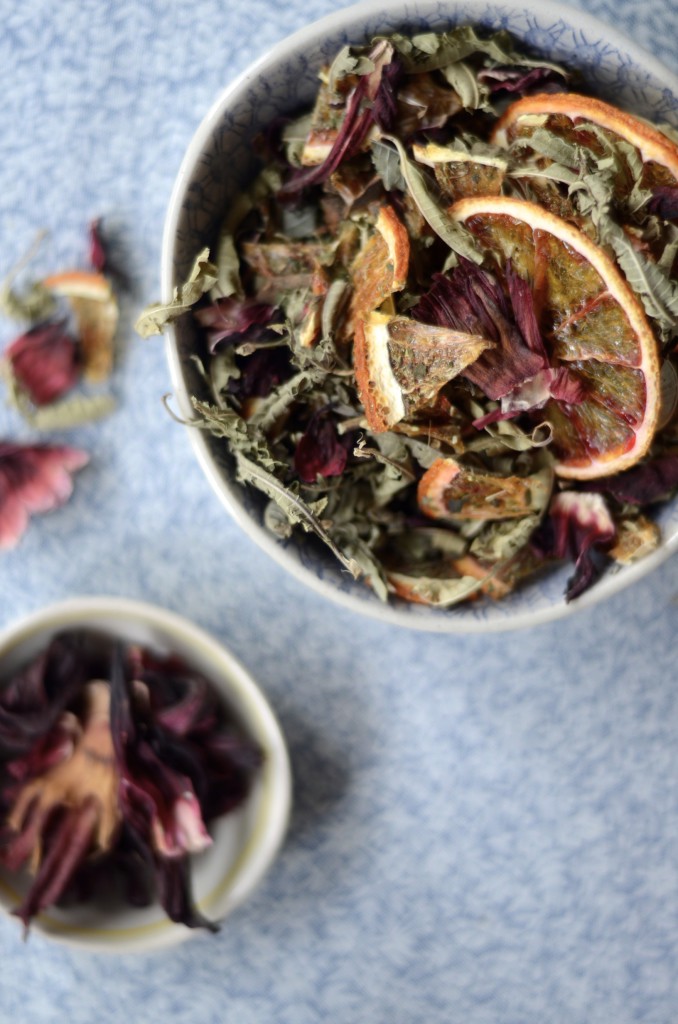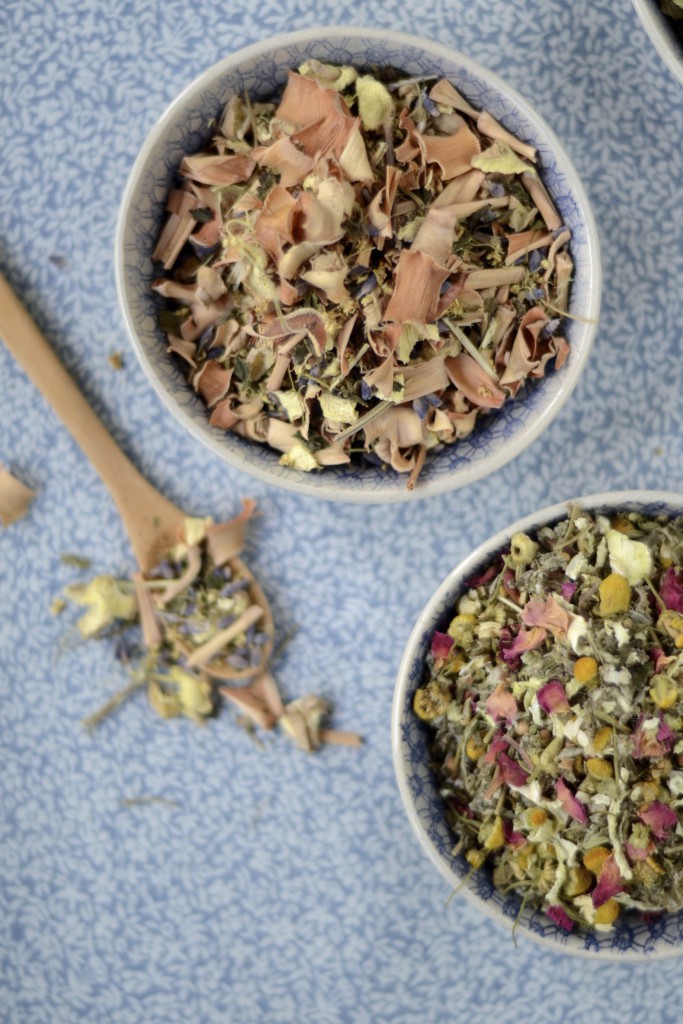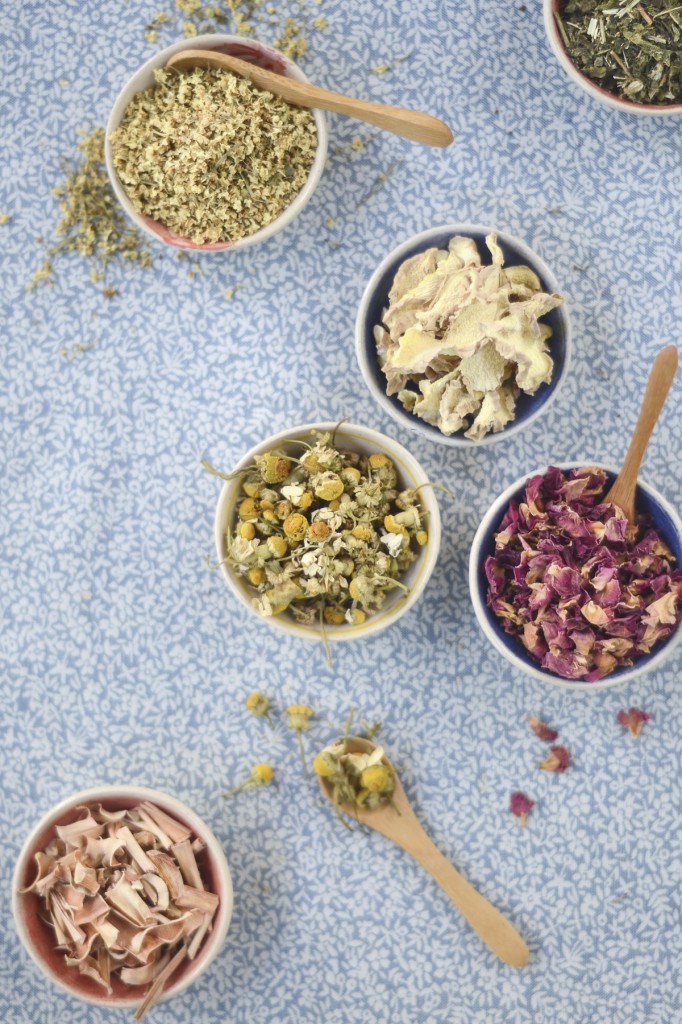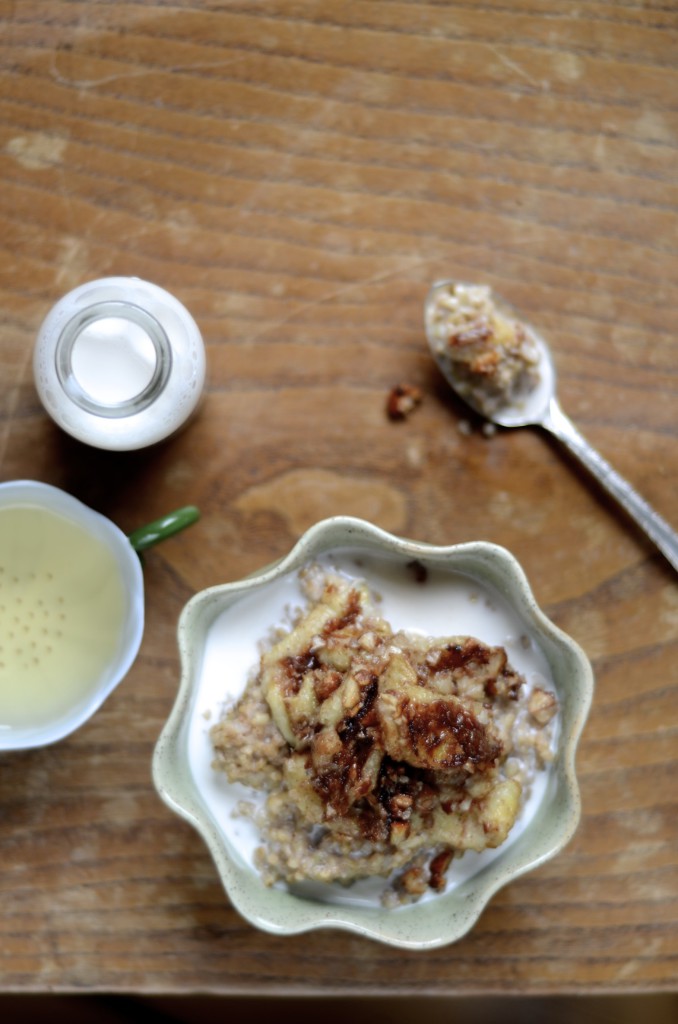Stuffed heirloom tomatoes
Do you often have a bite of a tomato and wonder why you even bother buying them? Although beautifully uniform and bright red, commercial tomato varieties often lack taste.
One of the reasons for this was the move by tomato growers in the 1930’s towards tomato mutations with a “uniform ripening” gene, which ensured the fruits would ripen evenly from stem to tip, without leaving a harder, green part around the stem, deemed undesirable by consumers at the time. Unfortunately this mutation has a side-effect: by disabling the gene that creates the darker green colour around the stem, the chlorophyll (or chloroplasts), which converts sunlight into sugars for the plant, is removed, leading to a less sweet and tasty fruit. Thankfully some families and growers have passed the seeds from older varieties down from generation to generation because of their valued characteristics and taste. These heirloom varieties – now available at most markets – are usually much more tasty, albeit a little more expensive.
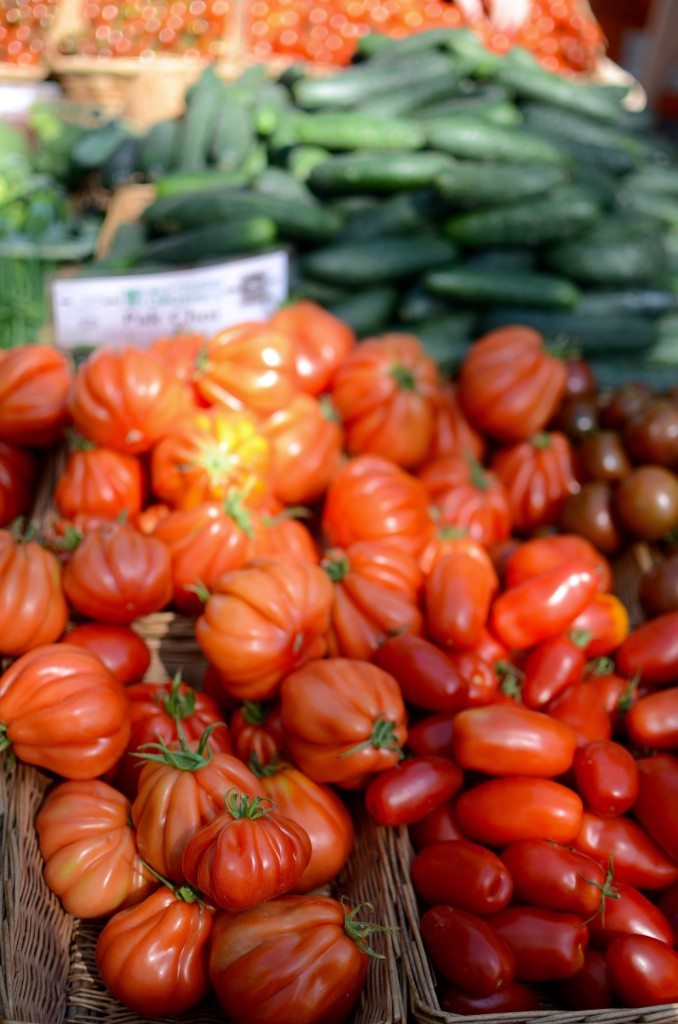 We’ve had a few very wet days lately, which meant the wonderful summer produce I bought at the market over the weekend had to find a rather more wintry purpose. I’ve always loved roasted tomatoes, but stuffing these beauties elevates them to the most perfect light meal imaginable.
We’ve had a few very wet days lately, which meant the wonderful summer produce I bought at the market over the weekend had to find a rather more wintry purpose. I’ve always loved roasted tomatoes, but stuffing these beauties elevates them to the most perfect light meal imaginable.
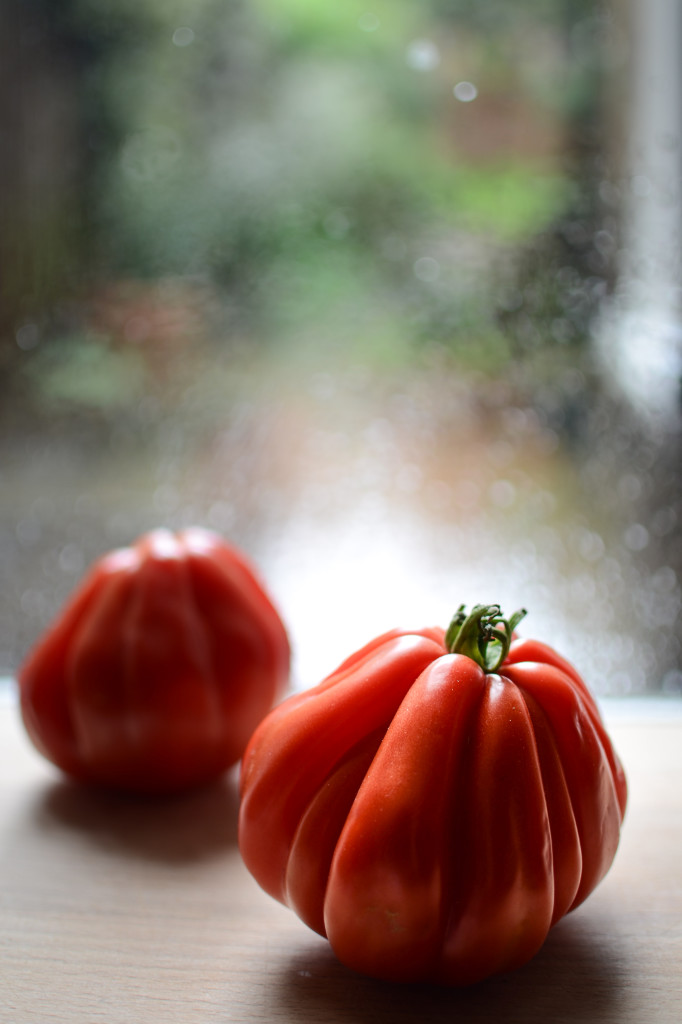 If you cannot find heirloom tomatoes for this recipe, use 4 large regular tomatoes. For the oven-roasted cherry tomatoes, cut 2 punnets of cherry tomatoes in half, toss in red wine vinegar and olive oil, season with salt and pepper, then roast cut sides up in a medium hot oven until caramelised (about 1 – 2 hours). I usually have a jar of these in my fridge, but you could also replace them with 60g of finely sliced marinated sun-dried tomatoes and increase the amount of rice slightly. Use the scooped out tomato flesh in your next batch of tomato soup or sauce, or blend with a pinch of salt and strain through a muslin cloth to make the most delicious tomato broth.
If you cannot find heirloom tomatoes for this recipe, use 4 large regular tomatoes. For the oven-roasted cherry tomatoes, cut 2 punnets of cherry tomatoes in half, toss in red wine vinegar and olive oil, season with salt and pepper, then roast cut sides up in a medium hot oven until caramelised (about 1 – 2 hours). I usually have a jar of these in my fridge, but you could also replace them with 60g of finely sliced marinated sun-dried tomatoes and increase the amount of rice slightly. Use the scooped out tomato flesh in your next batch of tomato soup or sauce, or blend with a pinch of salt and strain through a muslin cloth to make the most delicious tomato broth.
Serves 4
Ingredients
2 heirloom beef tomatoes (about 800g), cut in half horizontally and flesh scooped out carefully
Ingredients for the filling
extra virgin olive oil
1/2 large red onion, finely diced (about 1/2 cup)
1 stalk celery, finely diced
1 teaspoon sea salt
1 teaspoon mixed dried herbs (parsley, basil, tarragon, oregano etc.)
125g oven-roasted cherry tomatoes (about 1/2 cup firmly packed)
85g (1/2 cup) cooked brown long-grain rice
1 – 2 teaspoons lemon juice
100g tin sardines in brine or olive oil, drained and broken up slightly with a fork
3 tablespoons finely chopped parsley and dill
150g fresh ricotta cheese, preferably made with unpasteurised milk from grass-fed animals
Method
- Pre-heat the oven to 180°C/360°F.
- Heat a glug of olive oil in a saucepan over a medium heat. Add the onion, celery, salt and dried herbs, and cook until softened (about 5 to 10 minutes).
- Now mix together all the ingredients for the filling, except the ricotta, and allow to cool.
- Fold the ricotta into the filling briefly, leaving it in tact as much as possible.
- Spoon the filling into the tomato halves, place into an ovenproof dish that fits them snugly and bake at 180°C/360°F for about 30 to 40 minutes (or until the tomatoes are very tender). If the filling is starting to get too brown after about 20 minutes, cover with foil.
- Serve with a crisp green salad and green beans, or on toasted sourdough.
Wild garlic and leek sauce
I love greens and the spear-shaped wild garlic leaves (or ramsons and ramps) are no exception. This pungent member of the allium ursinum family is a wonderful combination of onion, garlic, spring onion and chives, with the added bonus of growing quite abundantly in woods and hedges during the spring months. The leaves can be quite stringy, so I often chop them up finely or process them, cooked or raw. The tiny white flowers are edible too and make for a beautiful garnish. This sauce will surprise you with its complexity, yet comforting more’ishness. Enjoy it with egg dishes (such as the fried egg and beetroot rösti below), stirred through pasta or risotto, and with any combination of cheese and carbs you can think of.
Ingredients
1 medium to large leek (about 200g), trimmed, cut in half lengthwise, sliced and washed
1 – 2 medium cloves garlic, roughly chopped
1 bunch wild garlic (about 100g)
1 medium bunch parsley (about 50g), thickest part of stalks discarded
sea salt
125ml (1/2 cup) extra virgin olive oil
squeeze of lemon juice to stir through just before serving
Method
- Fry the leek and garlic in a little butter (or olive oil, if you keep the temperature nice and low) until tender and caramelised.
- Add the wild garlic and stir until wilted. Remove from heat.
- In a food processor, blitz all the leek mix and the parsley until finely chopped.
- With the motor running, add the olive oil in a steady stream through the chute. Add salt (and perhaps some freshly ground black pepper) and taste.
- At this stage I usually divide the sauce between two jars and freeze one of them. Add a squeeze of lemon juice to the other and have with pasta, egg dishes, mashed potatoes or anything cheesy.
Hot cross breakfast bake
I have an issue with Christmas decorations appearing in September. And hot cross buns being for sale all year long. They are such a treat precisely because they are usually only available during Easter – and, like fragrant strawberries in summer and nutty-sweet Jerusalem artichokes in winter, I so look forward to indulging in them for a brief period every year. Here is a recipe idea for a savoury dish making use of these little spiced buns and one of my favourite greens – cavolo nero.
Wishing you all a blessed Easter!
Hot cross breakfast bake
Serves 4
Ingredients
1 large onion, finely chopped
large knob of organic butter
50g (small handful) Tuscan kale / cavolo nero, leaves stripped from stems and roughly chopped
4 wholewheat, preferably organic, hot cross buns, sliced into 5 slices each (they can be a few days old)
3 pastured organic eggs
200ml (1/2 plus 1/3 cup) milk of your choice
small handful (about 20g) pine nuts, toasted in a heavy based pan until golden
large handful (about 40g) grated strong cheddar cheese
Method
- Preheat the oven to 180°C/350°F.
- Heat the butter, add the onion and cook over a medium heat until soft and translucent. Now turn up the heat and cook for another 20 minutes, stirring regularly to avoid the edges catching.
- While the onion is caramelising, “steam” the kale briefly in a little water until bright green and wilted. Refresh under cold running water and squeeze out any excess liquid.
- As soon as the onions are golden and sweet, set aside to cool slightly.
- Butter each of the hot cross bun slices with butter and stack in an ovenproof dish. Scatter over the toasted pine nuts.
- Now place the onion, kale, eggs and milk in a blender and blend briefly until the kale is finely chopped (but not completely liquidised). Carefully pour this mixture over the hot cross buns and leave to stand for at least 20 minutes.
- Sprinkle over the grated cheese and bake for 30 to 35 minutes or until golden and set.
- Remove from the oven and allow to cool slightly before serving.
Green crêpes with cayenne cashew cream
We love pancakes in any shape and size. And it is one of the easiest way to serve vegetables to your family – either mixed straight into the batter or as a filling. These Tuscan kale crêpes, a.k.a. dragon slayer pancakes, are delicious with a savoury cashew cream, but you could also serve them with grated (preferably unpasteurised) cheddar cheese or goat milk feta. And I usually reserve some of the batter to make a few plain ones to have with honey and lemon as a special Pancake Day dessert.
Ingredients for the crêpe batter
5 medium eggs
240g (2 cups) wholemeal spelt flour
500ml (2 cups) water
large pinch of sea salt
200g Tuscan kale (also known as cavolo nero, dinosaur or lacinato kale), thick cores discarded, roughly chopped
Method
- Steam (or briefly blanch) the kale until wilted, then refresh under ice cold running water.
- Put all the ingredients in a blender and blend until well mixed.
- Set aside for at least 1 hour.
- To make the crêpes, heat a little ghee or coconut oil in crêpe pan until hot, but not smoking. Pour a ladleful of the batter into the pan, turning it while you pour to ensure you cover the base.
- As soon as the edges have browned (after a few minutes), carefully slide a spatula under the crêpe and flip it over for another couple of minutes. Repeat until all the batter has been used up.
Ingredients for the cashew cream
125g (about 1 cup) cashew nuts, soaked for 2 – 4 hours in fresh cold water
100 – 125ml (about 1/2 cup) water
large pinch of sea salt
1 teaspoon nutritional yeast flakes
generous squeeze of lemon
large pinch of cayenne pepper
Method
- Rinse the soaked cashews thoroughly, then place in a blender with just under half a cup of water (about 100ml), salt, nutritional yeast, lemon juice and cayenne, and blend until creamy.
- If you don’t have access to a high speed blender, the resultant cream will have a coarser texture.
- Adjust seasoning and spoon onto a green crêpe before rolling up.
A cuppa for the soul
I’ve always loved the idea of taking what nature has to offer and creating something that feeds not only the body, but also the soul. Herbal and floral infusions are a wonderful way of restoring harmony within. Below are three blends that serve different purposes, but can be enjoyed at any time by anyone after a couple of minutes’ steeping in hot water. I have included information on some of the ingredients, but it is only the tip of the iceberg, so do get in touch if you would like to know more.
***
Chamomile flowers
Chamomile is mostly known for soothing cramping tummies, for its mild sedative effect to aid in a good night’s sleep and because it relaxes the muscles. It is also antibacterial and improves immunity.
Cinnamon
Rich in manganese, iron, calcium, and fibre, cinnamon improves glucose levels and insulin sensitivity, but also lowers LDL (bad) cholesterol, triglyceride concentrations, and overall cholesterol levels without affecting HDL (good) cholesterol. Cinnamon is also antimicrobial and anti-fungal.
Dandelion
Dandelion tea detoxes and eases congestion of the liver, helps to purify the bladder and kidneys, improves digestion and aids weight loss. It contains calcium, magnesium, iron, zinc, potassium, vitamins B and C, and helps to purify the blood, regulate blood sugar and improve blood circulation. It also helps to ease bloating and aching joints.
Elderflowers
Rich in bioflavonoids, elderflower is a powerful antioxidant, antiseptic, anti-viral and anti-inflammatory herb. The most common uses are for colds and flu, sinus infections, and other respiratory disturbances, as well as allergies. As a supplement, elderflower can be used as a diuretic and its laxative properties can be helpful in relieving occasional constipation. Elderflower also reduces blood sugar levels, very similar to the way insulin works.
Fennel
Anti-bacterial fennel tea helps expel mucous, is useful in reducing gastro-intestinal tract spasms and flatulence, and in larger doses can help remove obstructions of the liver, spleen, and gallbladder. Fennel tea is a diuretic and also helpful in treating anaemia. It is said to stimulate milk production in nursing mothers and has long been used to prevent infant colic. Fennel tea can help relax the smooth muscles in the uterus, thus relieving menstrual cramps and discomfort during pregnancy. Fennel tea can help relieve conjunctivitis and sore eyes.
Nettle
Stinging nettle is one of the most powerful herbal infusions available to us. It is a diuretic and decongestant, an anti-histamine and a tonic. It is anti-inflammatory, anti-rheumatic, anti-allergenic, and anti-spasmodic, and helps alleviate respiratory tract disease and asthma. It stimulates the lymph system, which in turn boosts immunity. In pregnant and lactating women, it helps to strengthen the foetus and promotes milk production, and is also said to reduce bleeding. In other women, it can relieve menopausal symptoms and help with menstrual cramps and bloating. Nettle is said to aid sufferers of gastrointestinal disease, IBS, and constipation, and also supports the kidneys and helps break down kidney stones. Nettle furthermore supports the adrenals, and the endocrine health by helping the thyroid, spleen and pancreas. Some research also shows that nettle relieves neurological disorders like MS, ALS and sciatica.
Raspberry leaf
A wonderful tea for those trying to conceive, those carrying a wee babe, and those having produced one, raspberry leaf tea is said to increase fertility, relieve morning sickness, strengthen the uterine wall to improve chances of healthy implantation and the process of labour nine months later, and repair it thereafter. It is also rich in vitamins A and the B complex, iron, calcium, magnesium, phosphorous, and potassium in an easily absorbable form to help your baby grow and increase nutrient value of breast milk. Even for those not in the reproductive stage, it helps balance hormones.
***
The Mellow Rose
Ingredients
1/2 cup dried lemon verbena, crushed slightly
1 heaped tablespoon dried nettle
1 heaped tablespoon dried dandelion
1/4 cup dried hibiscus flowers, torn into smaller pieces
6 slices dried orange, chopped into small pieces
2 tablespoons crushed cinnamon bark or cassia
The Refresher
Ingredients
1/3 cup dried lemongrass, roughly chopped
1 heaped tablespoon whole ginger, roughly chopped
1 heaped tablespoon dried elderflowers
1 heaped tablespoon nettle
1 heaped tablespoon dried lavender
A Mother’s Heart
Ingredients
2 tablespoons fennel seeds
1 heaped teaspoon fenugreek seeds
1 tablespoon coriander seeds
1 tablespoon aniseed
1/3 cup dried raspberry leaf tea
1/3 cup dried chamomile flowers
1 tablespoon peppermint leaf tea
2 tablespoons dried red rose petals
1/4 cup chopped dried fennel
1 heaping tablespoon nettle
Method
1. Combine the first four ingredients in a spice grinder, high speed blender or mortar. Now blend or grind until the spices are partly ground, with some larger bits remaining.
2. Add the rest of the ingredients and mix.
Buckwheat and baked bananas for breakfast
Henry VIII, Elvis, Mufasa and Kong. All kings in their own right. Just like breakfast. I know, I know… You’ve heard this message a thousand times before, but it really is the most important meal of the day.
Eating a breakfast rich in complex carbohydrates, protein and healthy fats, wakes up your sluggish metabolism, restores glycogen levels, improves your mood and ability to concentrate, and sets you up for a day of healthy food choices.
There are as many variations on the morning meal theme, as there are countries, cultures and climates. Our family loves whole grain porridges, egg dishes and supercharged smoothies. Here is an easy recipe for a buckwheat and groats porridge, with sticky baked bananas.
Ingredients
Equal parts oat groats and raw buckwheat kernels
Sea salt
3 bananas (ripe, but not too soft)
1 tablespoon lemon juice (about half a lemon)
1/4 heaping teaspoon ground cinnamon
2 teaspoons liquid coconut oil
30 – 40g / 1/4 cup almonds, finely chopped
Method
- To improve the overall digestibility and health benefits of the grains, soak both for at least 12 (but up to 24) hours in warm acidulated water (lemon juice or raw apple cider vinegar works well), then rinse. If you would like to take it to another level altogether, allow to sprout in a sprouting jar or covered colander. They are ready to cook as soon as the little tail of germination becomes visible – usually after a day or two. Do not let it grow much longer, as it will not turn into a creamy porridge.
- Transfer the grains to a heavy-based saucepan, add just under double the amount of water and a very large pinch of salt. Bring to boil, stirring constantly, then reduce heat and simmer for 30 minutes. Stir occasionally.
- While the porridge is cooking, pre-heat the oven to 180°C / 350°F. Slice the bananas into thick (half centimetre) slices and toss gently with the lemon juice, cinnamon, coconut oil and chopped nuts. Spread on an oiled baking tray and bake for 20 to 25 minutes.
- With a spatula, carefully scrape the bananas off the tray. The caramelised undersides are what we’re after.
- Serve on top of your porridge with delicious nut milks or raw dairy
Note: I usually mix lots of ground nuts and seeds, as well as coconut oil or unpasteurised butter into our porridge to ensure it isn’t a carbohydrate-heavy start to the day.

